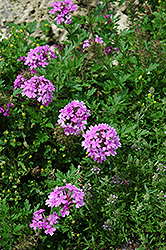Plant Library
Plant Height: 6 inches
Flower Height: 8 inches
Spacing: 14 inches
Sunlight:
![]()
Hardiness Zone: 6a
Other Names: Rose Verbena, American Verbena
Ornamental Features
Rose Vervain is smothered in stunning clusters of lavender flowers with purple overtones at the ends of the stems from early summer to early fall, which emerge from distinctive fuchsia flower buds. Its deeply cut ferny leaves remain forest green in colour throughout the season.
Landscape Attributes
Rose Vervain is a dense herbaceous perennial with a mounded form. It brings an extremely fine and delicate texture to the garden composition and should be used to full effect.
This plant will require occasional maintenance and upkeep, and should be cut back in late fall in preparation for winter. It is a good choice for attracting butterflies to your yard. Gardeners should be aware of the following characteristic(s) that may warrant special consideration;
- Spreading
Rose Vervain is recommended for the following landscape applications;
- Mass Planting
- General Garden Use
- Groundcover
- Naturalizing And Woodland Gardens
Planting & Growing
Rose Vervain will grow to be only 6 inches tall at maturity extending to 8 inches tall with the flowers, with a spread of 18 inches. When grown in masses or used as a bedding plant, individual plants should be spaced approximately 14 inches apart. Its foliage tends to remain low and dense right to the ground. It grows at a fast rate, and under ideal conditions can be expected to live for approximately 5 years. As an herbaceous perennial, this plant will usually die back to the crown each winter, and will regrow from the base each spring. Be careful not to disturb the crown in late winter when it may not be readily seen!
This plant should only be grown in full sunlight. It is very adaptable to both dry and moist locations, and should do just fine under typical garden conditions. It is not particular as to soil type or pH. It is somewhat tolerant of urban pollution, and will benefit from being planted in a relatively sheltered location. Consider covering it with a thick layer of mulch in winter to protect it in exposed locations or colder microclimates. This species is native to parts of North America. It can be propagated by division.


